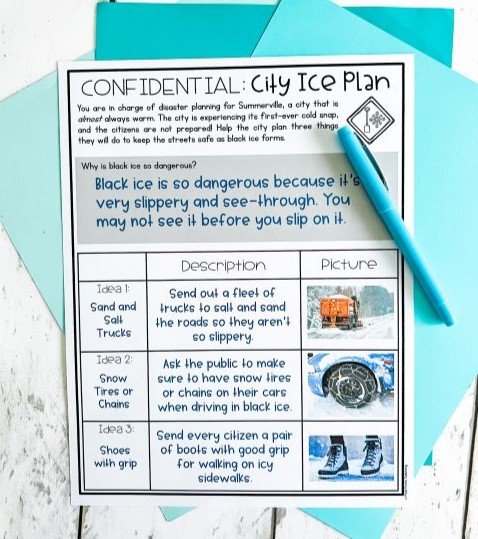Winter Science Experiments about Ice for Kids
When someone says the word ‘ice’, I can’t help but think about Elsa’s “Let It Go” song as she builds her ice castle. Am I the only one? Maybe I’m unique in that, but that’s OK. Ice is an exciting topic for kids to explore, and there are some awesome science activities for third grade to teach about ice and its hazards.
What is Ice? Why is it hazardous?
Ice is the solid state of water. Water will freeze when temperatures reach 0 degrees Celsius or 32 degrees Fahrenheit. Black ice is a thin layer of transparent ice and is a hazardous form of ice.
To help negate the effects of ice, trucks can sprinkle sand, dirt, or salt on the roads. People can also put snow tires on their vehicles to keep them from slipping as they drive.
The Easy & Fun Way to Explore Ice
Ready to explore the hazards of ice AND meet science and literacy outcomes? In just a few clicks you can grab everything you need: nonfiction reading, comprehension, and an engaging science experiment.
Ice, Icicles, and Frost - Videos for Kids
Here are a few engaging videos to help spice up any lessons about ice!
Where Do Icicles Come From? by SciShow Kids is a fun video about icicles and how they form when snow melts and refreezes.
Reading about Ice
Reading about ice is a great way to incorporate literacy into science. Students will read about the science of ice. They will also read about some of its hazards and ways to stay safe when the conditions are icy.
After reading, they will have the opportunity to answer comprehension questions.
Integrating Art - Ice Cube Painting
For a way to incorporate art into science lessons about ice, Thimble And Twig has a fun idea for making colored ice. Add food coloring to water and freeze it in an ice cube tray. Make sure to add a popsicle stick before freezing. Then students can paint on paper using the frozen cubes.
science experiment - Melting Mayhem
Experiment to see which substances help ice melt. Use substances like salt, baking soda, hot water, etc. Or have students brainstorm things they’d like to try.
While experimenting, review states of matter and have students record their findings. For step-by-step instructions and templates, check out the resource linked above.
science experiment - Slick as Ice
To teach students how slippery ice can be, experiment to see how far an object will slide. The night before the experiment lesson, freeze water on a long cookie sheet. Collect materials like a piece of carpet, cloth, and sandpaper. Gather straws and a small car.
To execute the experiment, lay the cookie sheet, carpet, cloth, and sandpaper on a flat surface. Have students take turns using the straw to blow the car across each surface. They will see that the cars travel more easily on the ice than the other items.
This isn’t a ‘proper’ experiment because there are uncontrolled factors like students using different-sized breaths while blowing through the straw, but this will help demonstrate that roads can be slippery when icy.
How Cars Lose Control on Icy Roads
City Safety Plan
Plan for a weather-related hazard in a fictional city with this quick and fun activity.
After learning about the hazards of ice, have students imagine they are in charge of a community that has never experienced a cold snap. Their job is to create an ice safety plan for their city so they can demonstrate their understanding of the topic. To save you time creating the template, check out the template in the resource.
The topic of ice can be quite exciting for our students. Have fun teaching about ice to your third-grade students!






